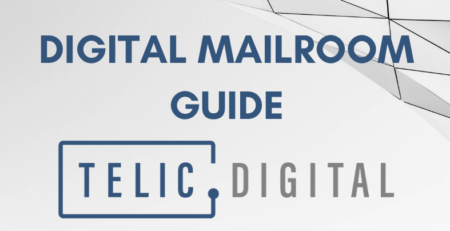Is the Digital Mailroom Solution Concept Still Relevant?
This blog post considers the background and relevance of the Digital Mailroom concept in 2021.
The original concept of the Digital Mailroom Solution was conceived in an era when handling and managing in-bound paper documents was the norm. Specifically, it originally focused on the process of digitisation and indexing of paper documents prior to being distributed via digital channels to relevant end-users such as knowledge workers, handlers, or processors in an organisation. In that sense, the Digital Mailroom can and should be considered as an enabler of digitisation, a true “Digital Transformation” step.
Digital Mailroom is a broad term that drives process owners to consider how best to get randomly presented, unsorted, uncategorised documents into a form where they can be expeditiously routed to the correct group, role or individual largely without human intervention. For this reason, Digital Mailroom Solutions were initially implemented in large-scale operations managing time-sensitive or highly regulated processes.
Contemporary Digital Mailroom solutions typically stage; document classification, data extraction and verification of structured content as scalable server-based processes to achieve digital mailroom automation. Document routing should be viewed as simply the start; once completed, the original “simple” document that was originally intended to be solely human-readable, increases in business value. The extracted dataset can be used via APIs (Application Programming Interface), RPA (Robotic Process Automation) or BPM (Business Process Management) tools to automatically trigger events and to update line of business applications.
Digital Mailroom systems were originally deployed at organisations with centralised operations, i.e. a managed facility implemented to handle all the needs of disparate groups within an organisation. Taking a moment to consider this fact, it’s how early scanning centres were organised. These facilities were relatively expensive to setup and operate; they were usually managed by the same team as physical mail and so hence the close mailroom connotation.
Digital Mailrooms were, and still are, especially relevant where paper documents are abundant. Advocates of the approach are quick to include inbound emails and messaging into the same solution, i.e. a single conduit that can automatically handle and process all streams of in-bound documents irrespective of their format and channel.
For reasons outlined above, Digital Mailrooms are heavily promoted with or alongside Document Management, Content Management and Workflow systems as well as RPA and BPM solutions. After all, many important business processes are triggered by the receipt of an inbound email or document or form.
The other challenge of the Digital Mailroom Solution proposition is the use of eCommerce standards for interchange of data; think “EDI for the 21st Century”. eCommerce systems deliver the opposite of the definition above “randomly presented, unsorted, uncategorised” as they present information in a predictable and readily digestible form for information systems. These largely negate the business drivers for a Digital Mailroom.
Do Digital Mailroom solutions reflect today’s needs and how do organisations implement these system
It’s clearly advantageous for organisations to insulate knowledge workers from low-value tasks by automatically classifying and indexing documents and messages. Moreover, the benefits of digitising paper documents to enable automated processing through the same classification and indexing software are well adopted and proven.
For me, the value of a Digital Mailroom Solution is predicated on the effectiveness of its automated document classification or document identification capabilities. This task is a critical step as the assigned Document Class defines the likely structured dataset contained within it, as well as the workflow path, and ultimately the final-destination application, with appropriate security and access control attributes.
In addition to extraction of structured data to index the document, Digital Mailroom solutions can identify and automatically redact sensitive information that would represent a liability if allowed to remain in situ.
Sentiment Analysis can be configured to score documents with a uniform rating that can be used to determine appropriate actions such as “red-flag” review or escalation.
Integration with an organisation’s applications and information is key and solutions such as Kofax’s Transformation technology include a sophisticated database locator that uses fuzzy matching to associate new documents and messages with records in an organisation’s systems of record. This is an incredibly powerful mechanism that essentially mimics the way skilled human operators match documents with cases, transactions or customer records; the difference is that Digital Mailrooms can do this with high accuracy, applying additional rigorous checks and completed within a couple of seconds.
As requirements expand, some organisation baulk at the notion of merging content from “native” digital channels into a hitherto paper document oriented Digital Mailroom Solution. The reason for this is that there is a natural shift in operational responsibilities, i.e. the mailroom department acquires some ownership of processes that were outside of their former, physical domain. With ownership comes responsibility; Information Governance such as data privacy and security as well as the integrity and resilience of upstream processes that often depend on accurate and timely delivery of information. In my experience, this transfer of responsibilities rarely happens, the mailroom team continues to run the document scanning operation and all other inbound, digital channels are managed by Operations teams that are closely aligned with IT. Solutions to ingest and process messages are implemented as integrated modules to email systems, or are delivered as autonomous sub-systems to support specific Business Process Automation projects, i.e. BPM or Workflow solutions.
Thus, in the predominantly digital world, the concept of a Digital Mailroom Solution is bifurcated into two elements: i) the handling of remaining paper documents and ii) the handling / processing of unstructured information. The latter element is a real area of value and opportunity for Digital Transformation and Business Process Automation.
Whether staged centrally or distributed at a departmental level, the digitisation or scanning of paper documents is often appended as a natural step in the overall paper handling process. There’s no mystique or magic here: envelopes are opened, documents prepared and scanned using Document Capture Software before being uploaded into a Workflow and / or Content Management system.
The processing or transformation of unstructured information is a more important matter as this really gets to the heart of the revised Digital Mailroom proposition. The handling of this unstructured content can be viewed as phases that should immediately resonate to many readers of this blog post because we typically perform this frequently in our jobs:
- Identification and classification of the information This may be a formal classification or a loose one depending on what the document or message relates to. E.g. a notice of intended prosecution or a new contract or an invoice can and should be categorised as such – they have a “business imperative” characteristic. In contrast, an enquiry, sales communication, or confirmation / acknowledgements are handled in a looser way.
- Extraction of relevant structured information or dataset The embedded dataset links the document or message with an established or new process, e.g. an insurance claim will include incident, dates, times, policy no, details of counterparties etc. To ensure integrity and compliance, process owners need to be rigorous in their selection and application of verification, e.g. business rules, to this data.
- Capture of other pertinent data, e.g. entities such as dates, email addresses, telephone numbers and postal addresses may be worthwhile additions to a supplementary dataset. Care should be taken to ensure that appropriate information is stored to support the intended process only.
Supporting tools and technologies
There are essentially two groups of tools for managing in-bound, unstructured information.
The first set of tools are classic “advanced” Document Capture solutions that perform document classification and data extraction (aka indexing) for all inbound documents at the time of ingestion. These solutions are considered effective for automating these tasks, staging any exception handling and then exporting them to back-end systems such as Content Management and / or workflow / BPM solutions as well as line of business applications. These systems are often categorised as Automated Document Processing, Advanced Document Capture or Cognitive Capture solutions. They typically attempt to normalise content by converting a scanned image into a fully searchable document in a ubiquitous format such as MS Word or PDF.
The second approach acts on documents that are already captured and exported into a repository. These may include Enterprise Content Management or even file systems on servers using rudimentary meta-data (such as sender, date, type etc) as the initial organisation and indexing structure (think folders for originator and or date). Once stored, these new documents are automatically indexed in situ using a Discovery Software solution that allows complex queries to be very quickly run across them; These queries can automatically generate XML export lists allowing other standard tools such as workflow, BPM and RPA to execute processes. These export lists are analogous to the notion of “to-do lists for robots”.
Which solution is a better fit? As always, it depends on requirements and there are merits and disadvantages in both methods; although the staging and set up is different, these systems work in similar ways and can deliver similar outcomes. Both employ machine learning techniques and both offer sophisticated content analysis tools such as entity extraction and sentiment analysis that allows them to handle of large volumes of unstructured information.
The Advanced Capture system approach is quite fixed in its design and generally takes longer to configure and deploy. In contrast, the Discovery software solution provides more flexibility and less time to setup and deploy. This factor is especially important for dynamic situations where the structured dataset to be exported is subject to frequent change and index queries may need to be re-run across the whole repository.
Fundamentally, these differences can be contrasted as follows: Advanced Capture systems process documents to generate actionable index and meta-data. Whereas, Discovery systems query already generated index data to provide a view or optional list of actionable index and meta-data. These solutions have tended to gravitate towards specific use cases: Advanced Document Capture for transactional or case-oriented documents and Discovery for compliance and Information Management requirements irrespective of the underlying business processes.
In summary
The Digital Mailroom concept is relevant today, although evolution and necessity (i.e. a global pandemic) has resulted in paper documents being the exception. However, due to the same pressures, there is a greater need to automatically classify and extract meaningful, relevant structured information from inbound electronic documents and messages. This is an imperative for organisations as they re-organise themselves to face the challenges of WFH and changed market dynamics. Many argue that the ultimate benefit of Digital Mailrooms is to automate upstream tasks that are triggered by these inbound documents and messages. Automation is essential to improve the productivity of Knowledge Workers and to allow them to fully exploit the value of information. The underlying software technologies that deliver document classification, indexing and verification stages should be considered carefully as should the overhead of setup; the availability of machine learning to reduce the setup time and effort is a significant step.
The good news is that Operations teams considering the Digital Mailroom Solution approach now have a plethora of underlying software tools at their disposal. Depending on the intended use case, Document Capture and Document Discovery options can be used to complement each other or can be used independently. Both solutions deliver power and capability to the Digital Mailroom and in so doing, improve productivity, reduce errors and processing time as well as improving critical areas of information governance and compliance. In short, the relevance of Digital Mailrooms is greater than ever; while the original use case has both shifted and expanded, the essential proposition makes it a worthwhile investment for the majority of organisations.









